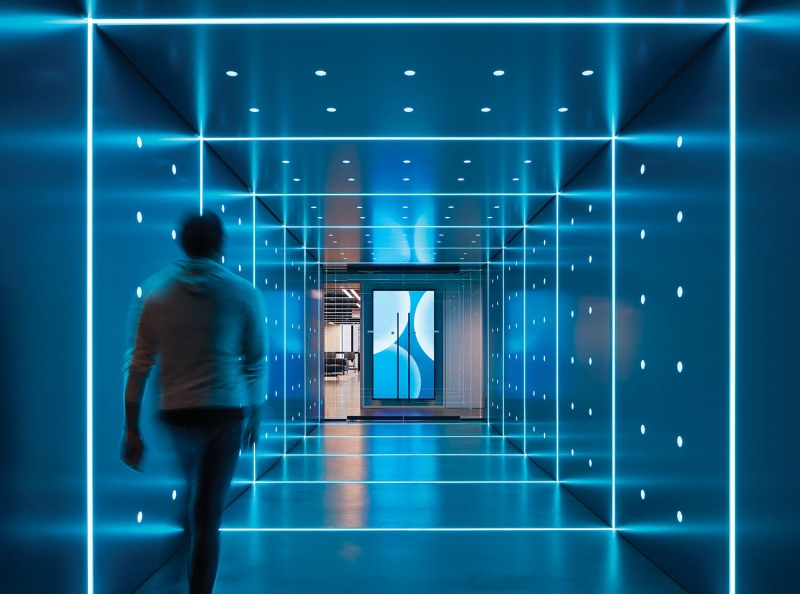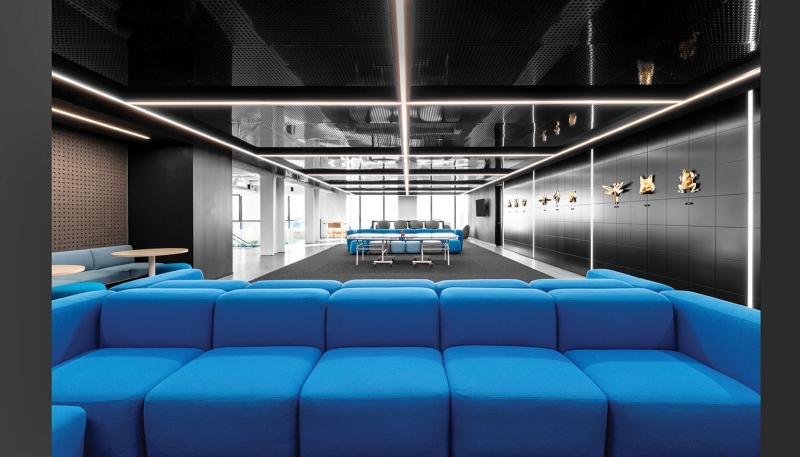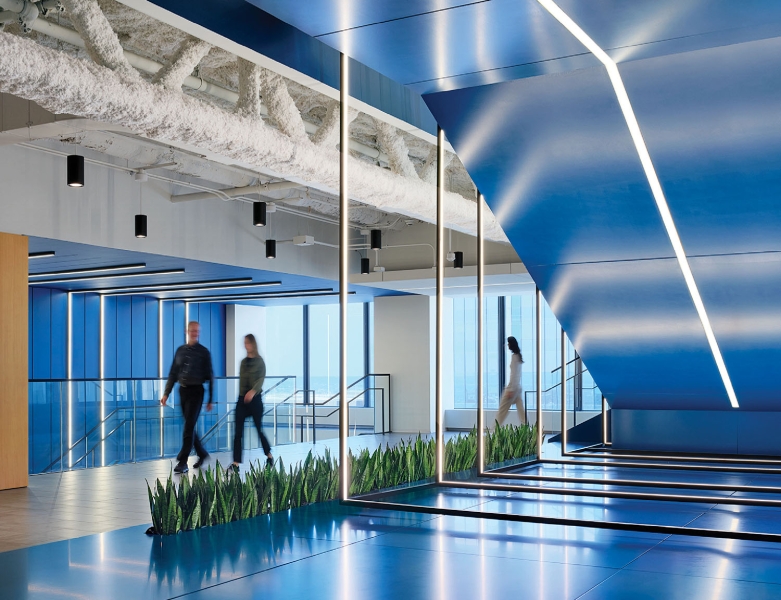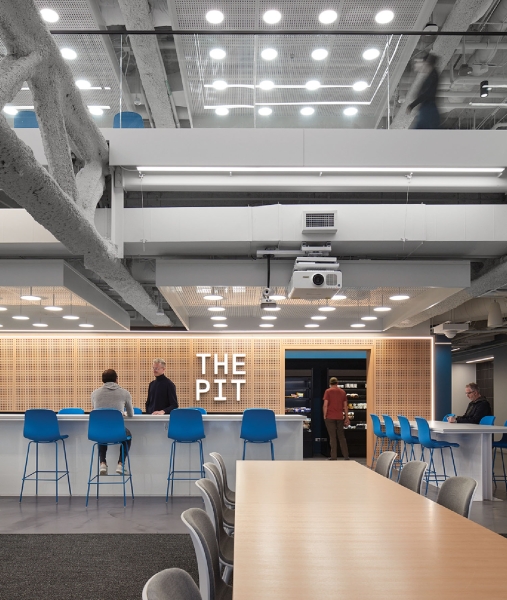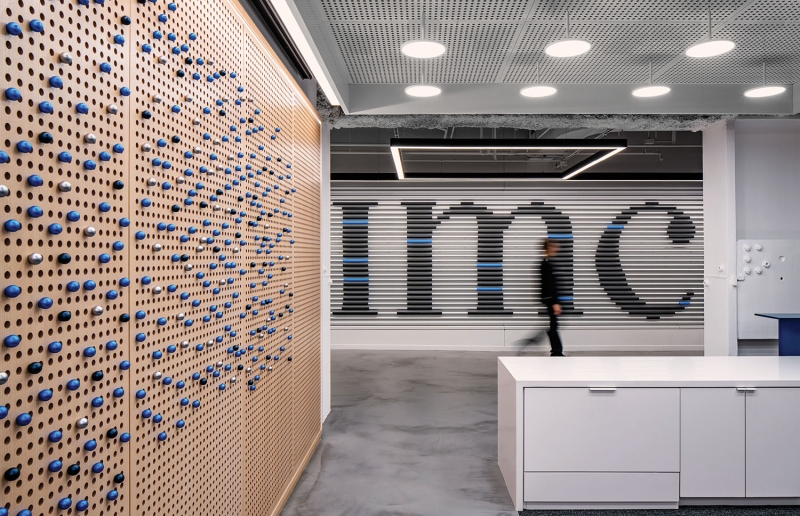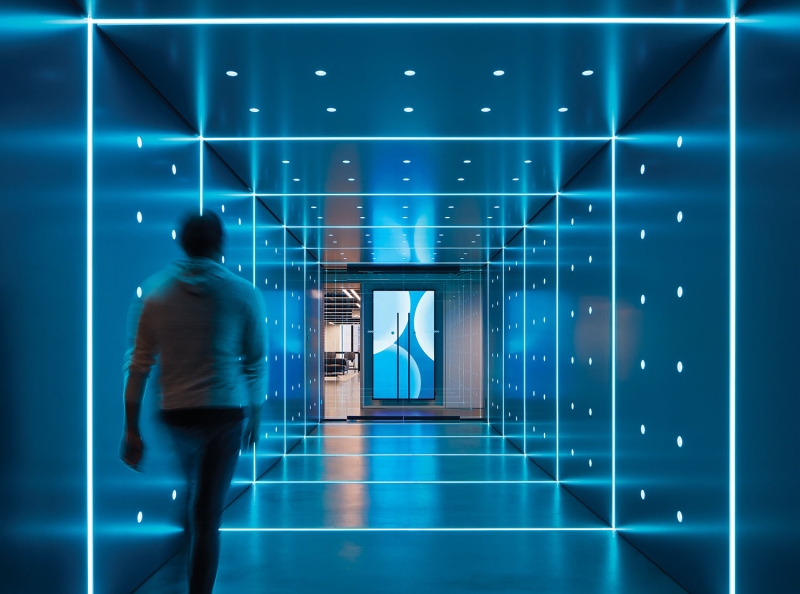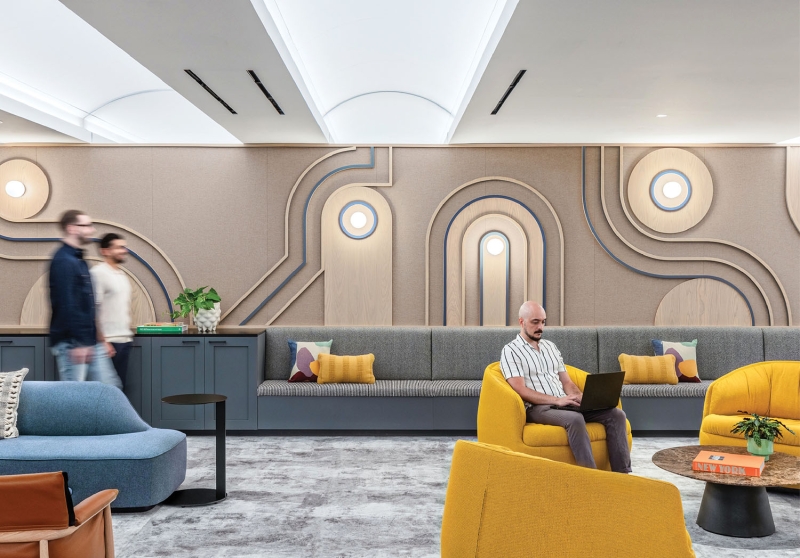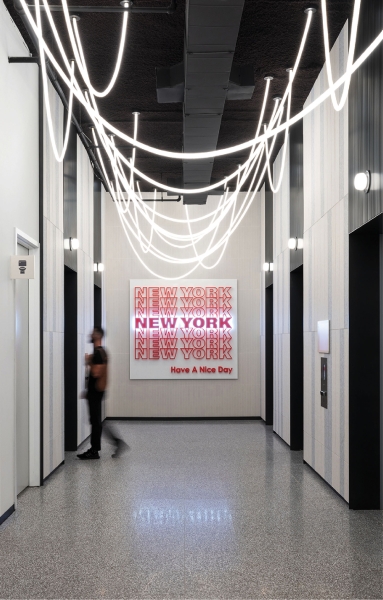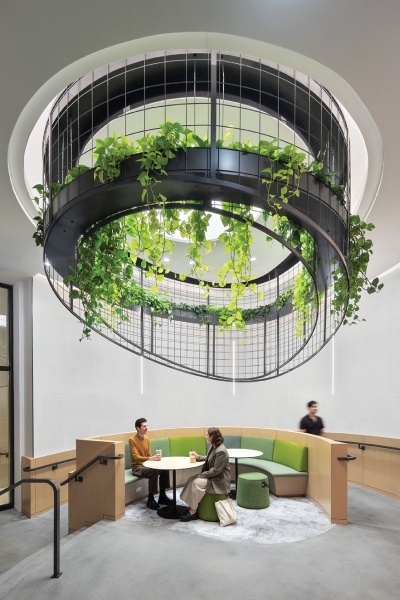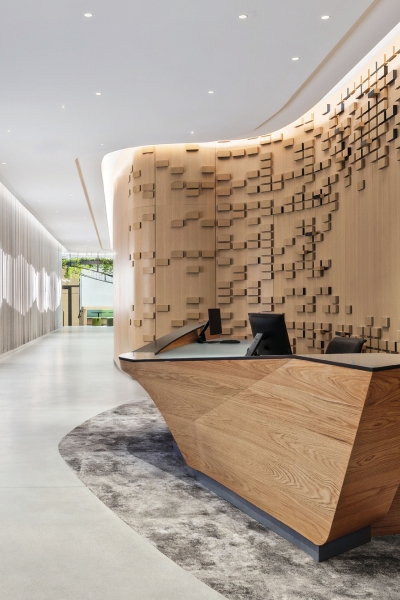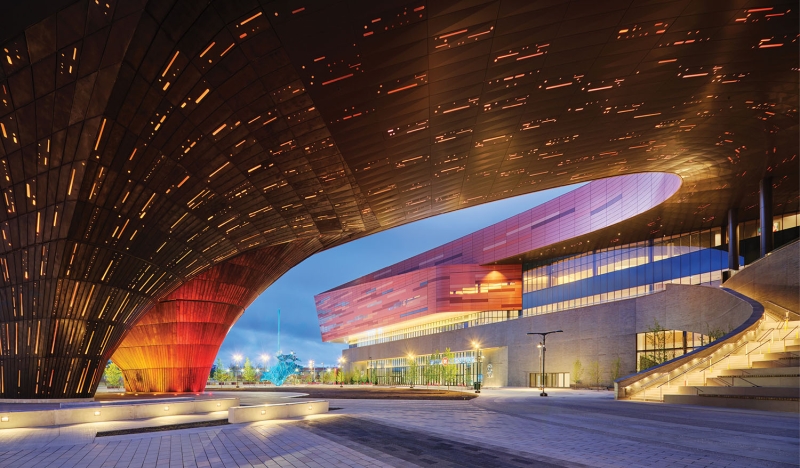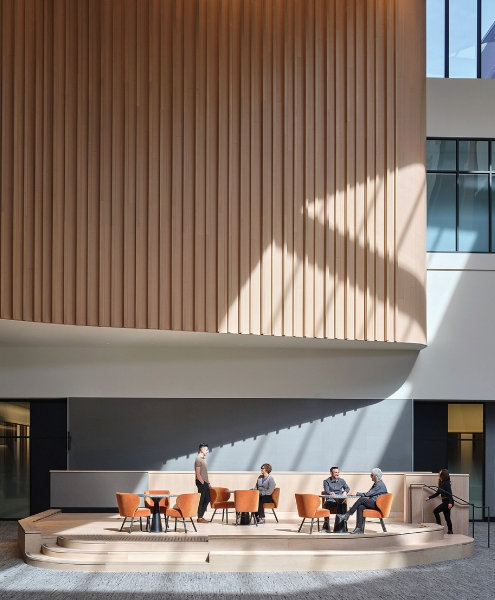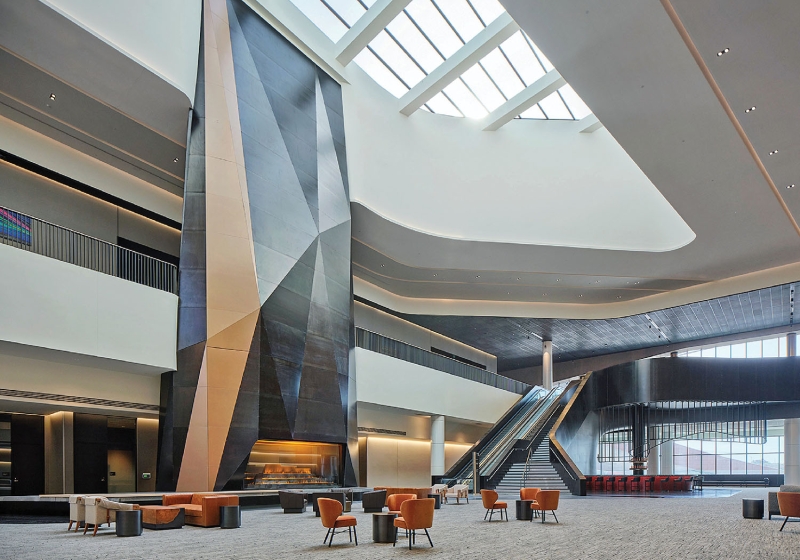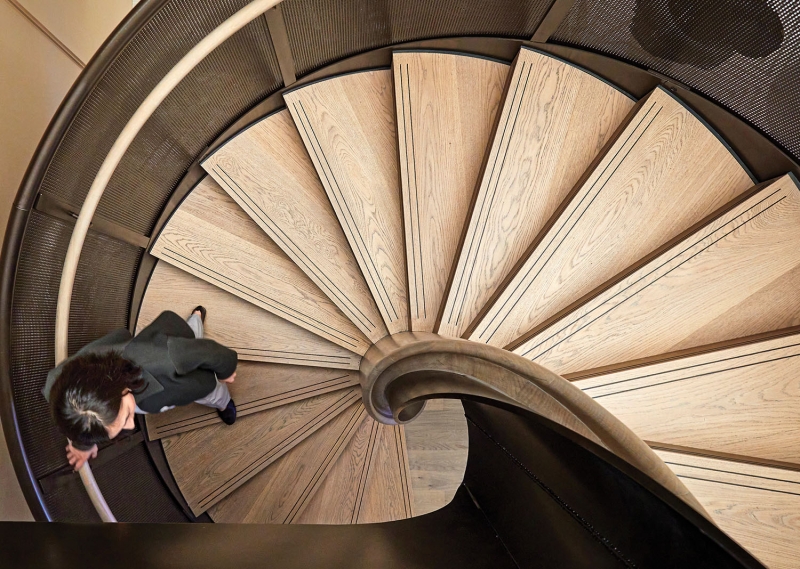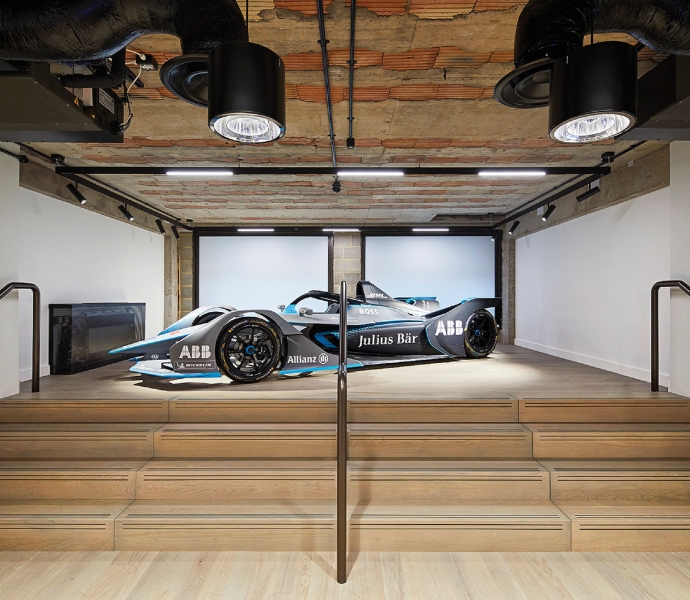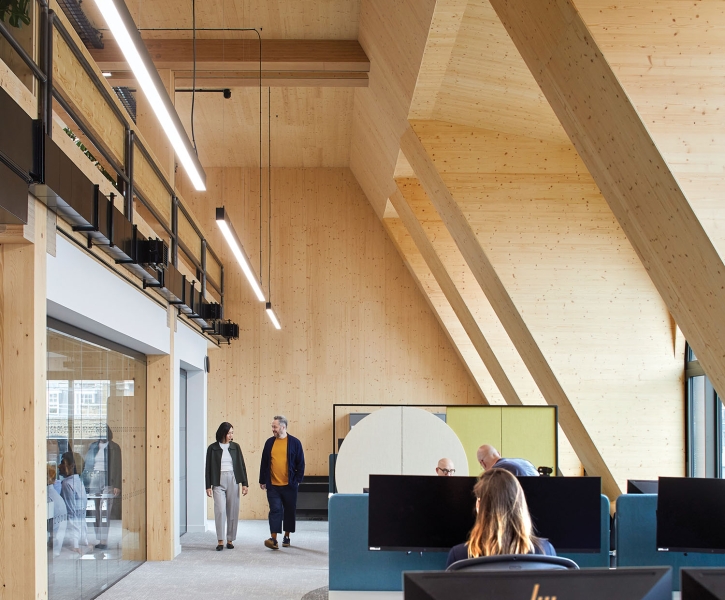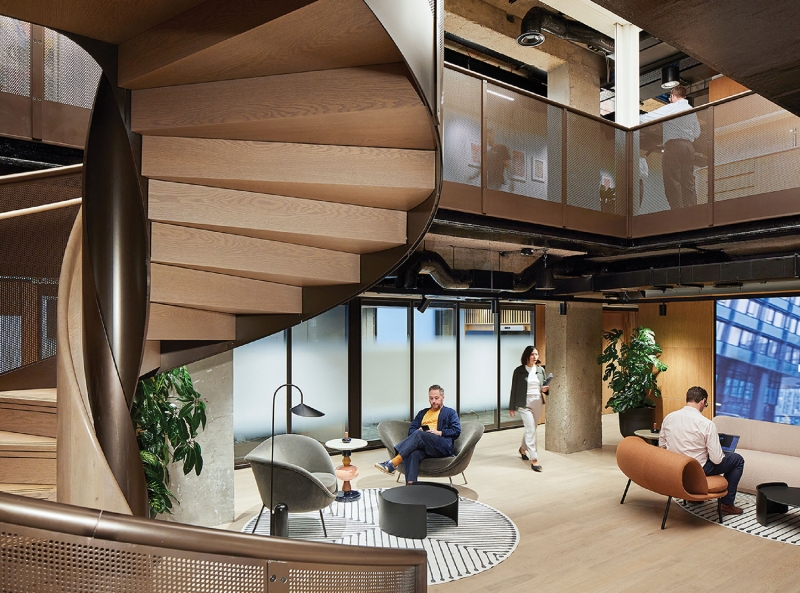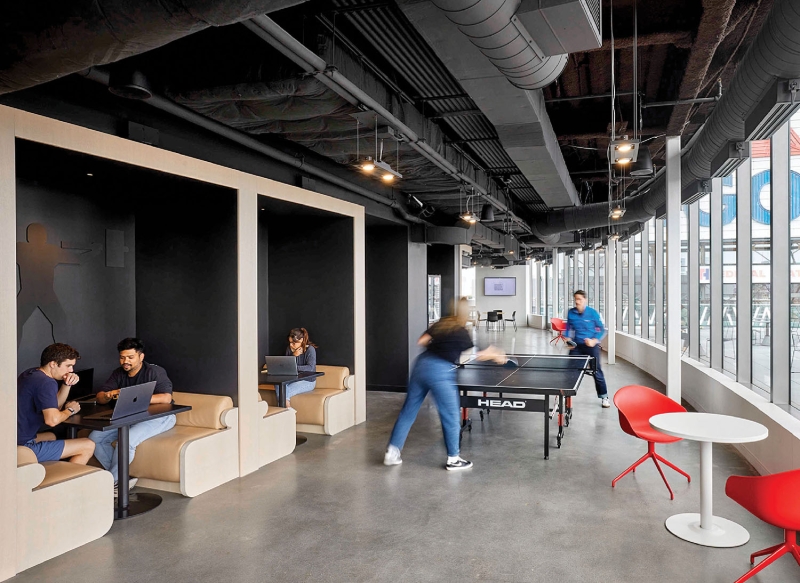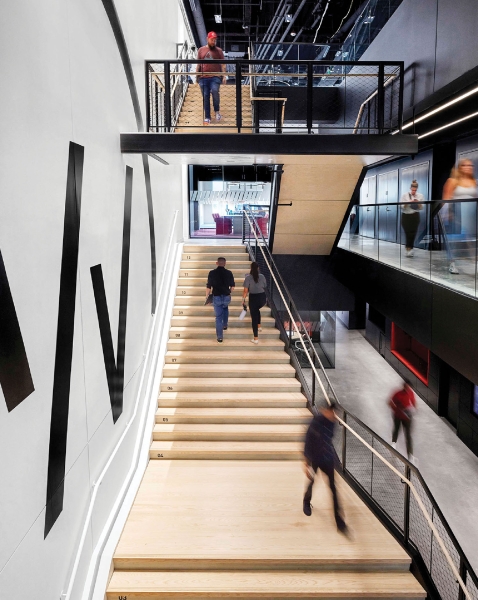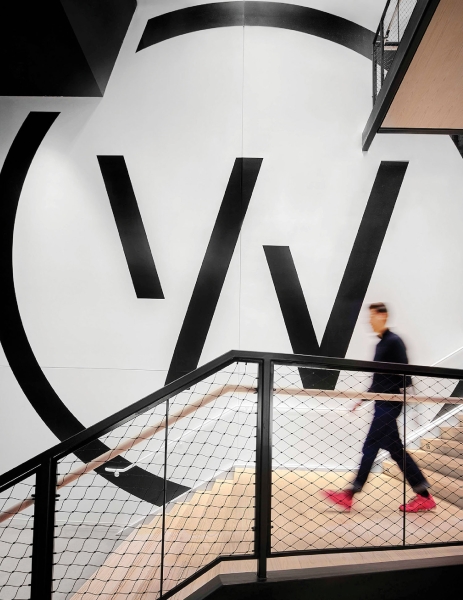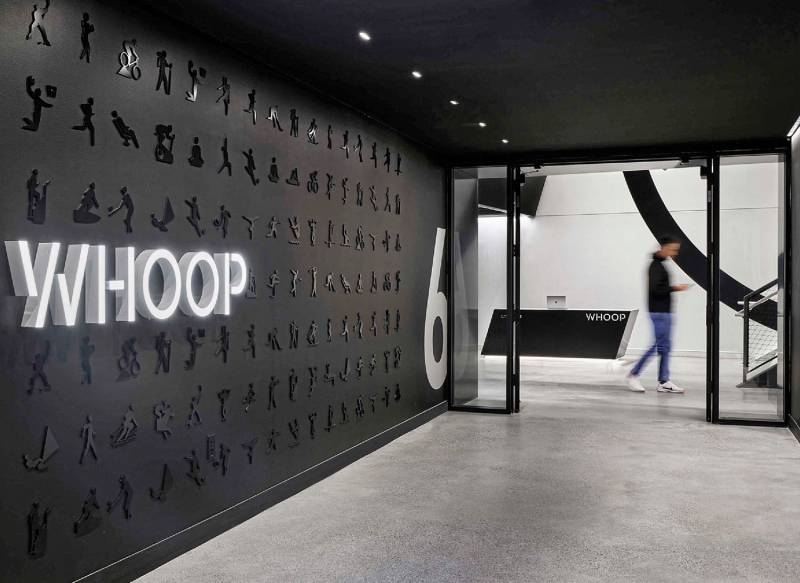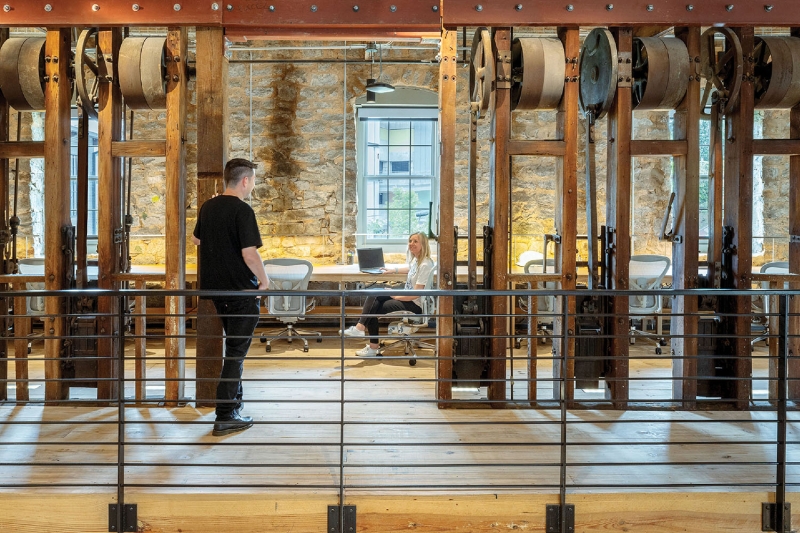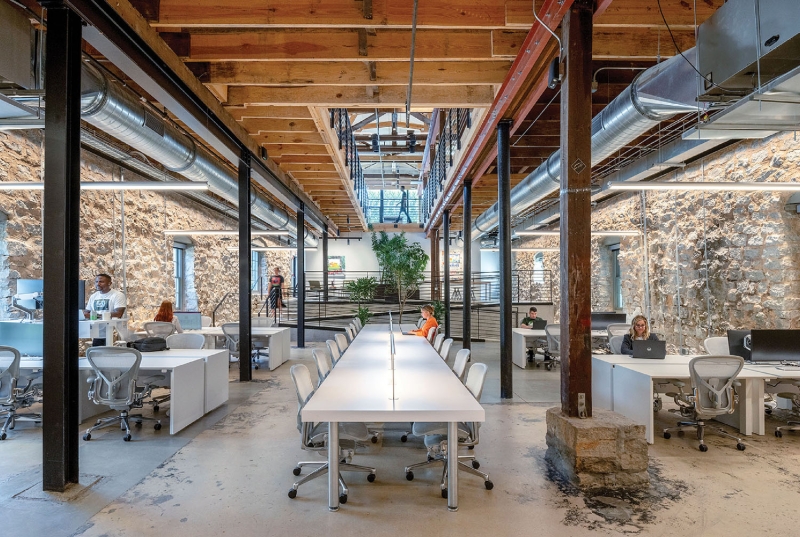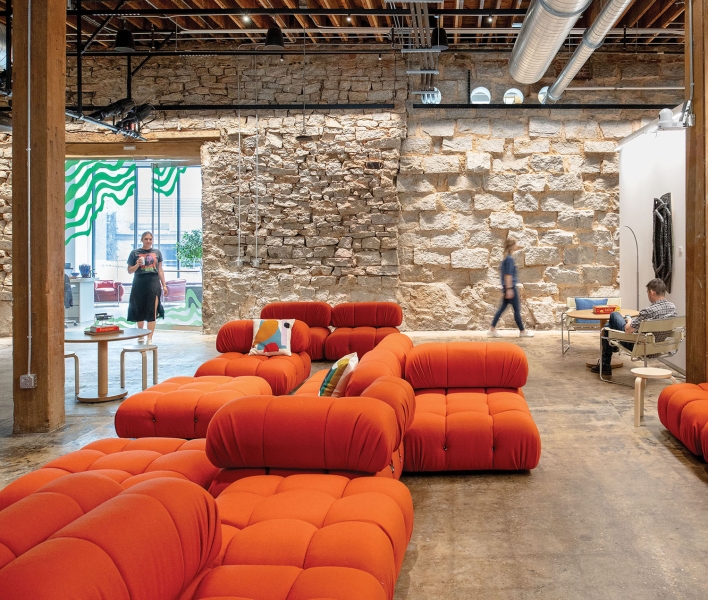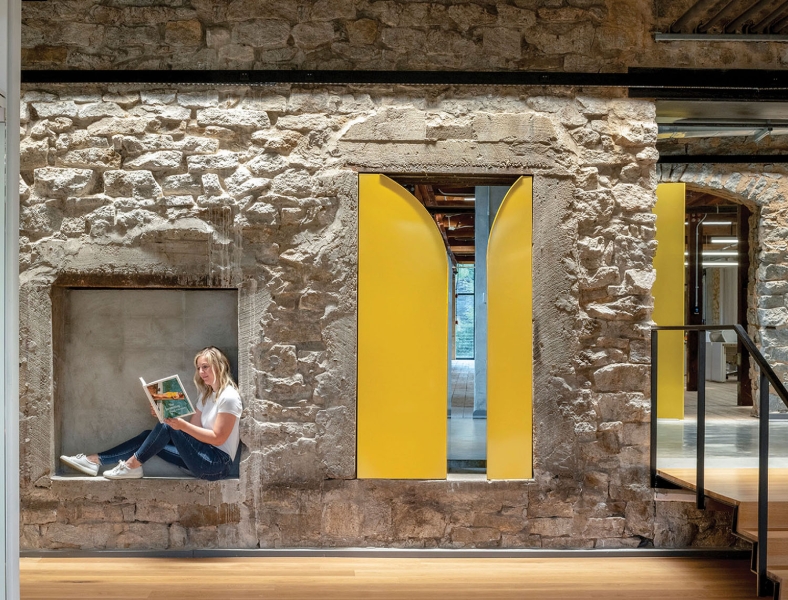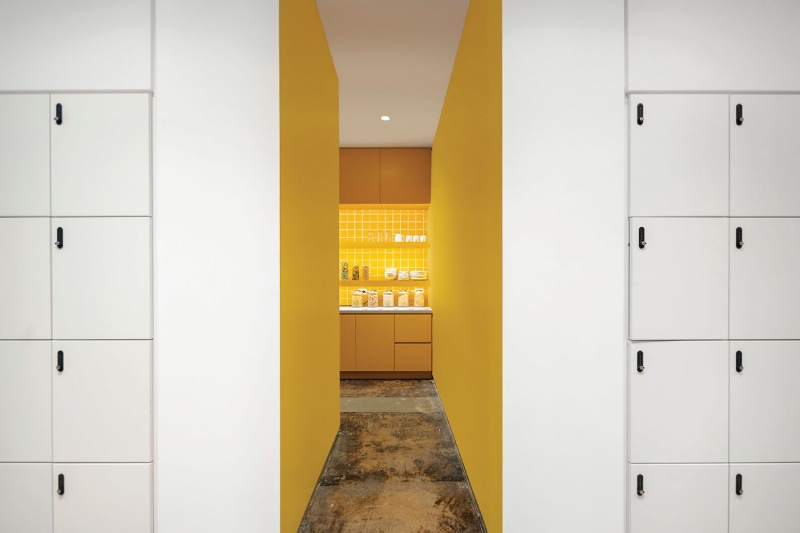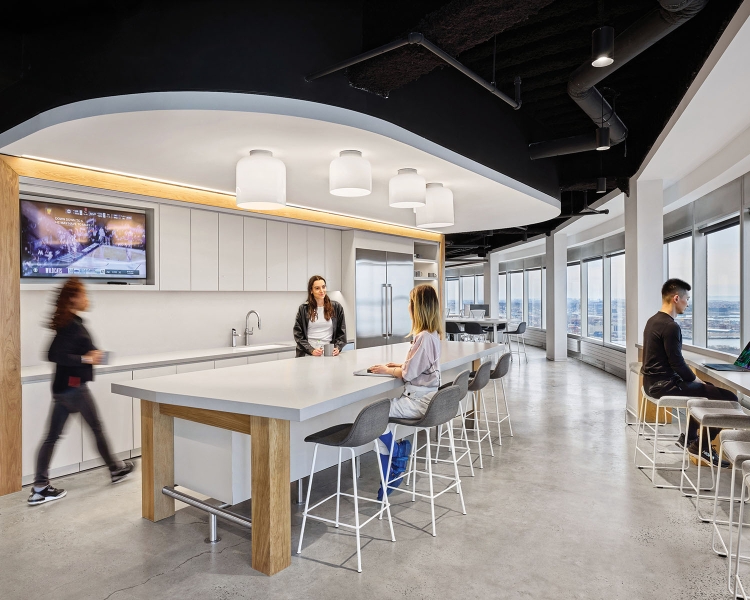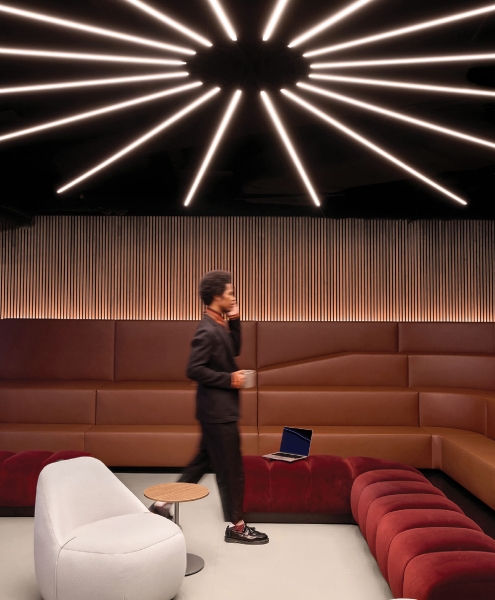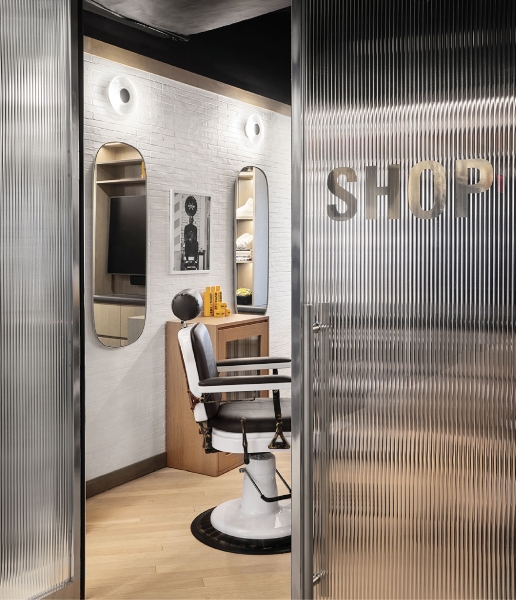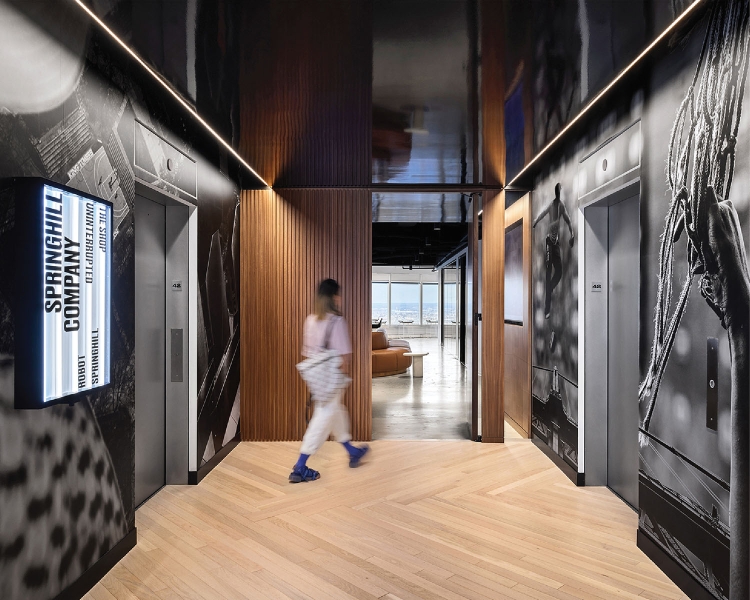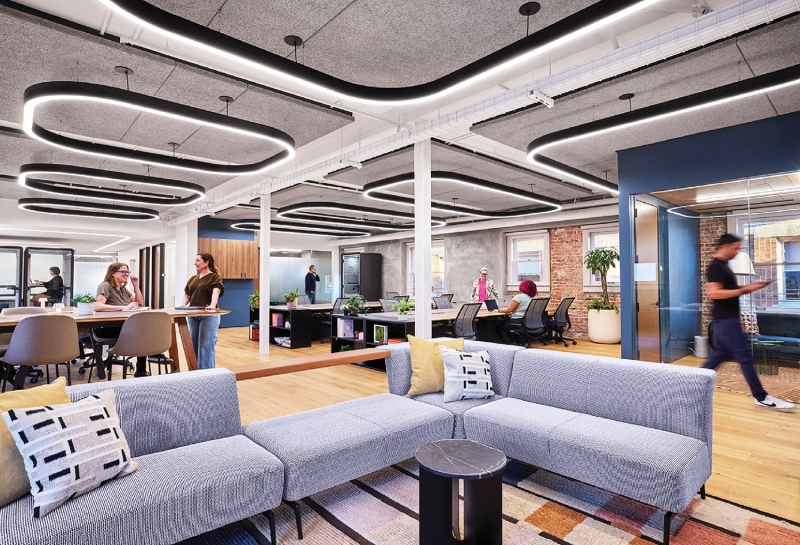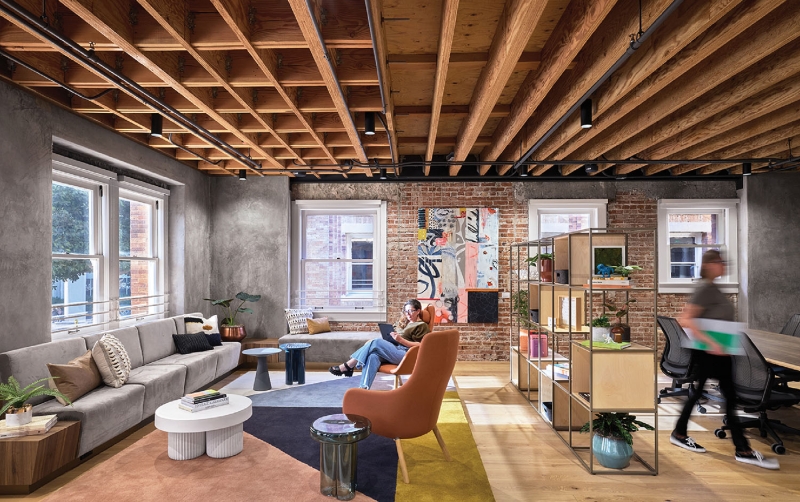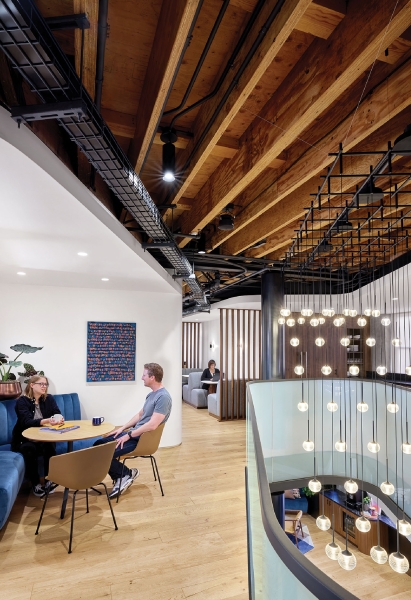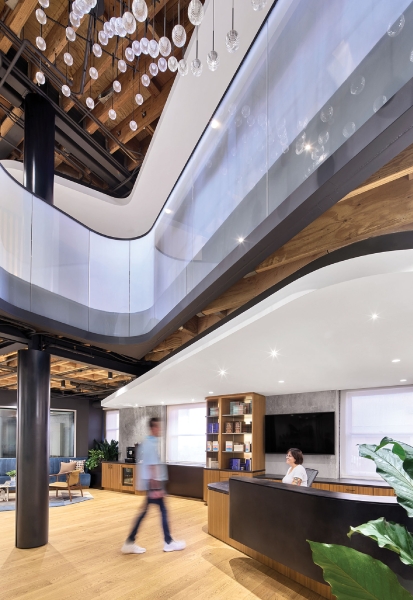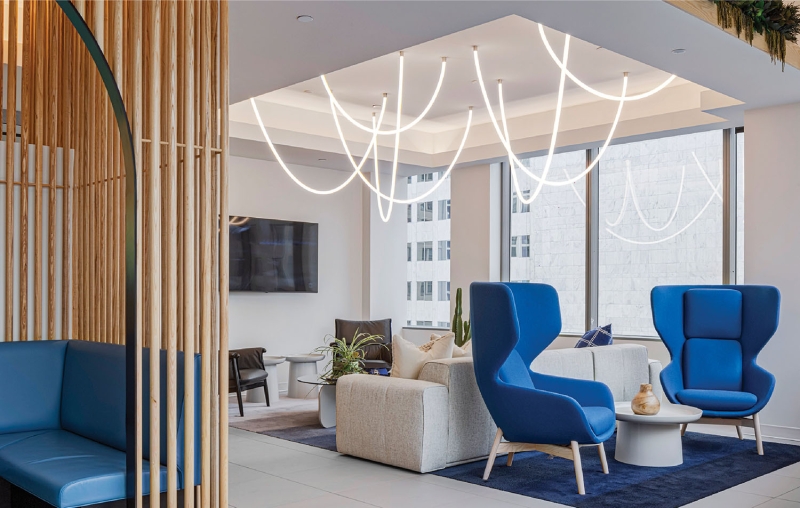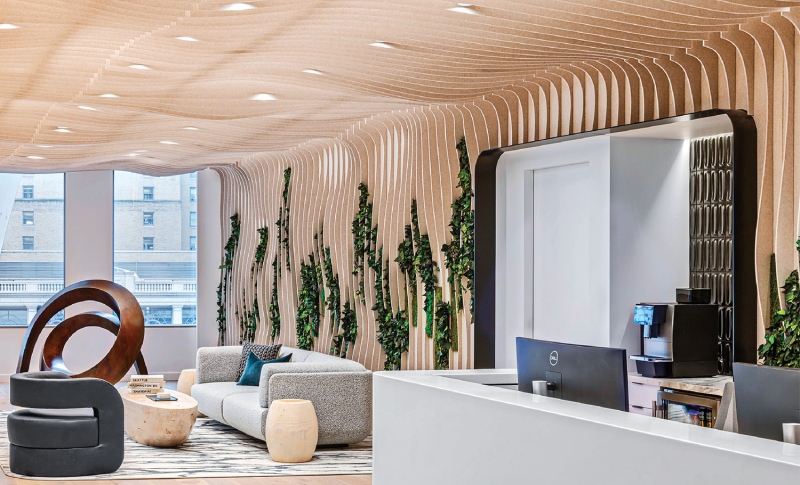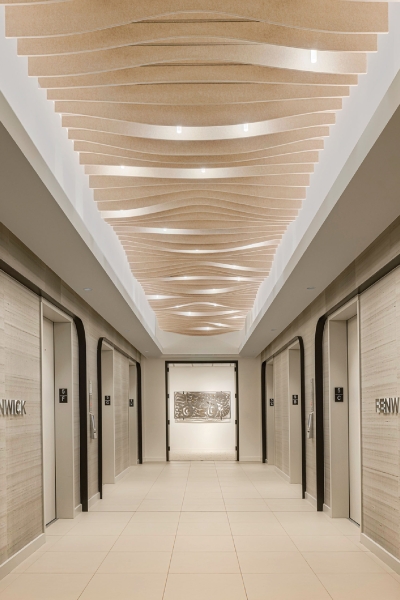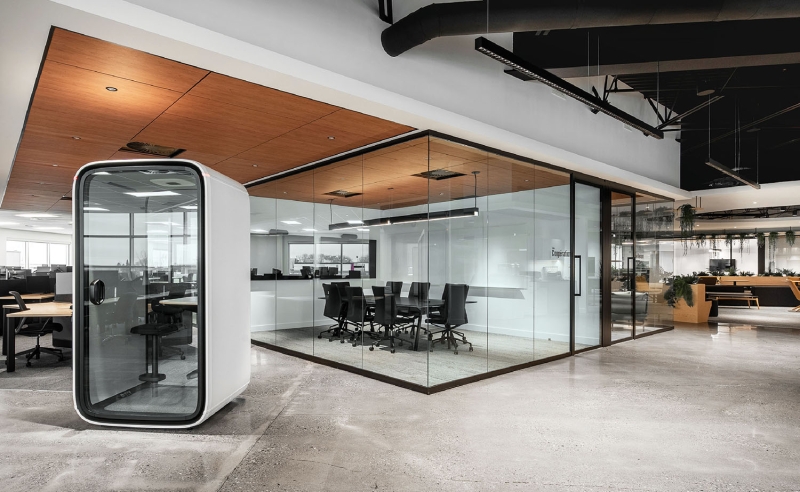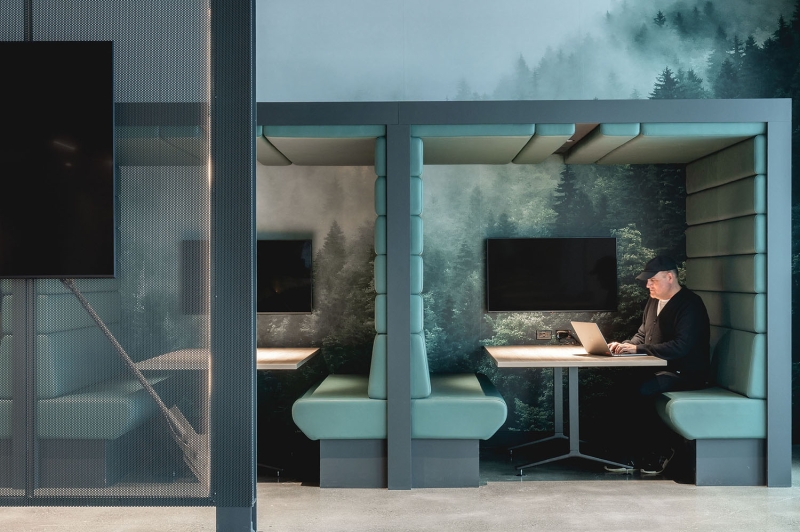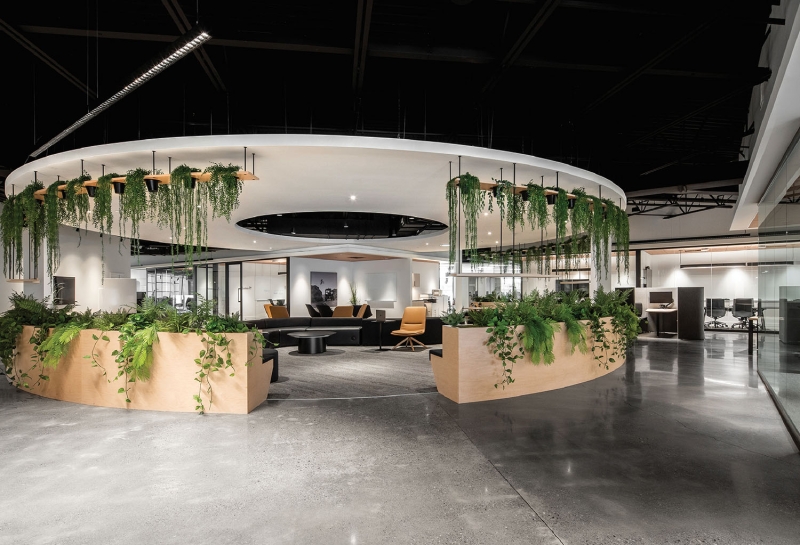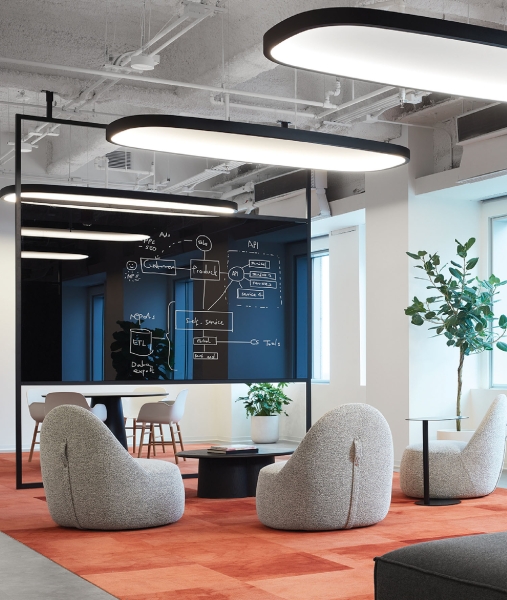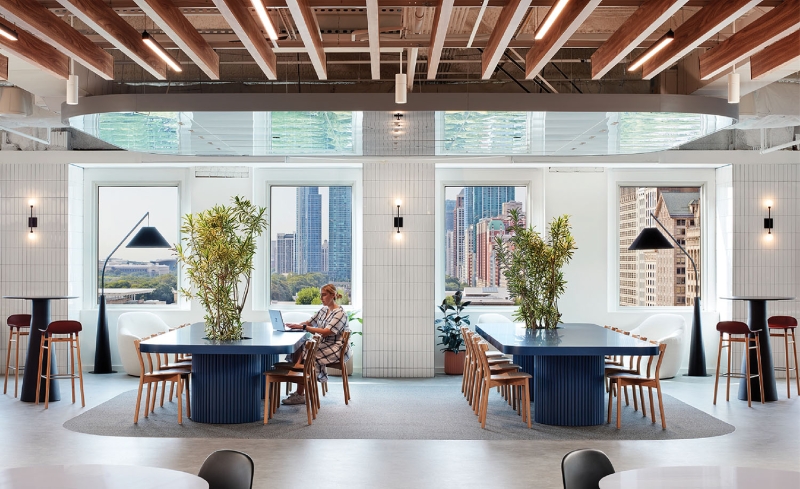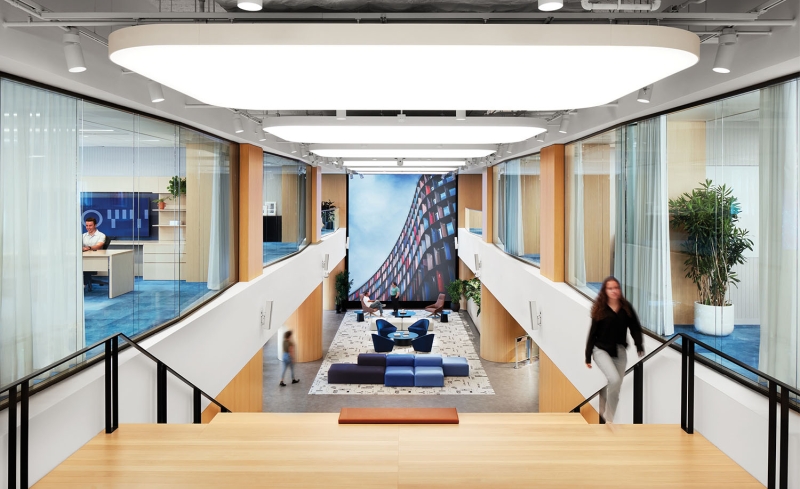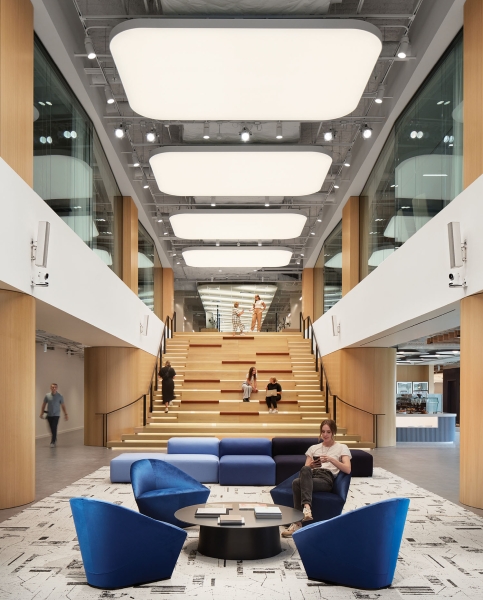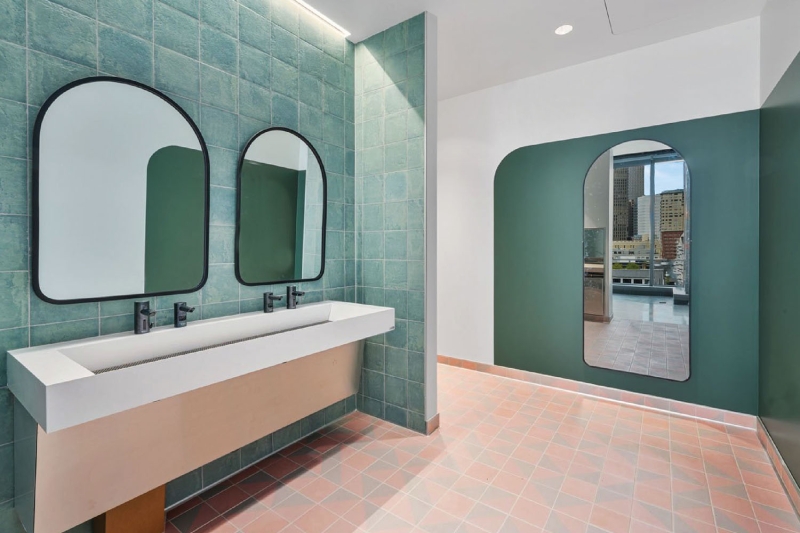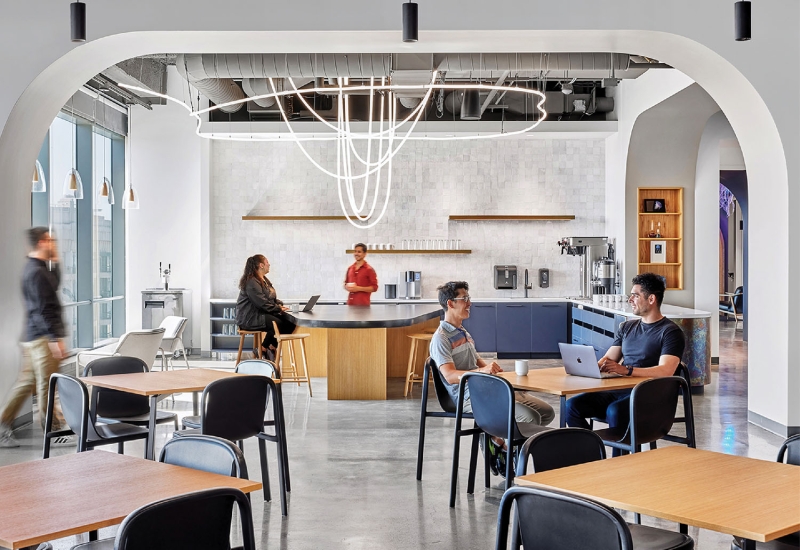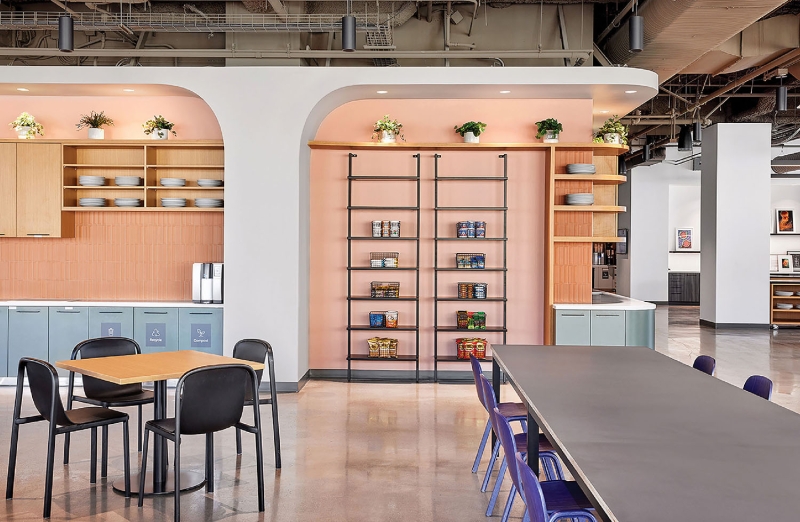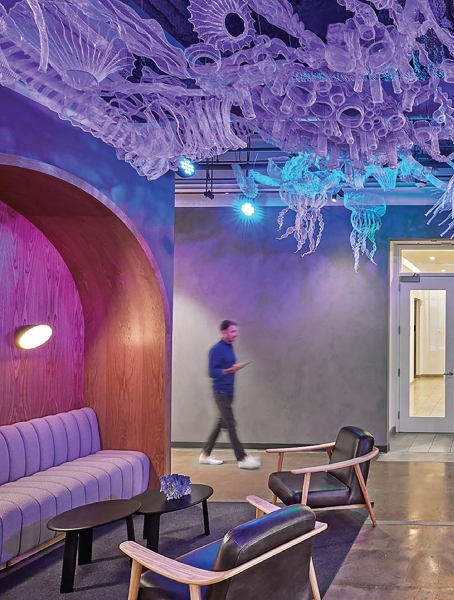Contents
- 1 Be Inspired By These Next-Level Corporate Workspaces
- 1.1 IMC Trading by Perkins&Will
- 1.2 Ad-tech Office by Vocon
- 1.3 BMO Centre by Populous and Stantec
- 1.4 Julius Baer by HLW
- 1.5 Whoop by Studios Architecture
- 1.6 The Mill by CannonDesign
- 1.7 Fulwell Entertainment by Spectorgroup
- 1.8 Financial office by Blitz
- 1.9 Fenwick by Huntsman Architectural Group
- 1.10 BRP by Ædifica
- 1.11 Benchling by Revel Architecture & Design
Photography by Angie McMongial.
From a New York office inspired by barbershops to a Seattle headquarters with cocoon-like nooks, explore these corporate spaces designed by Interior Design‘s 2025 Top 100 and Rising Giants firms.
Be Inspired By These Next-Level Corporate Workspaces
IMC Trading by Perkins&Will
PrevNext
The three-phase expansion of the Dutch-owned multinational trading firm’s North American headquarters added 1 ½ floors, doubling its size to 150,000 square feet. The newly enlarged Chicago office now spans three stories in the city’s tallest building, connected by a series of open stairs that create a dynamic central hub. At the heart of the layout, Perkins&Will inserted a bustling zone with a café, two barista areas, a catering space, and an adjacent gaming room—spaces that foster spontaneous interactions and create a social core for the more than 700 employees to gather, relax, and connect. These amenities are more than just pleasant perks; they offer an ideal venue for staff meetings and philanthropic events, promoting a sense of community within IMC. Company branding is thoughtfully integrated throughout, highlighting its history, core business, and market capabilities while unfolding a cohesive narrative that emphasizes its identity and energized presence. Offering a purpose-driven environment that sets a benchmark in corporate workplace conceptualization, this project was an Interior Design Best of Year Awards honoree. —Peter Webster
Interested in learning more about Interior Design’s 2025 Giants of Design? Check out our report for Top 100 Giants and Rising Giants, with more to come.
Ad-tech Office by Vocon
PrevNext
In the Gilded Age, furriers, milliners, and dressmakers occupied a stretch of Flatiron District blocks known as the Ladies’ Mile, showcasing wares to well-heeled shoppers through ornate window displays in cast-iron storefronts. One such landmarked 1899 building now houses an ad-tech firm’s five-story office. The 147,000-square-foot vertical campus is LEED Gold–certified and, according to Vocon design director Lauren Dennison, “inspired by the rhythm of the city grid and the warmth of New York’s diverse communities.”
A pixel-effect wall of white-oak blocks greets employees and visitors in reception, where flooring is polished concrete inlaid with meandering sections of carpet tile. Nearby is the “pocket park,” a seating nook beneath a garden by John Mini Distinctive Landscapes that cascades from an LED fixture resembling a sunlit oculus. On the top floor, a flex space with plush but streamlined seating is backdropped by a wall of deco-esque patterns created by accenting curved oak panels populated by RBW’s Dimple sconces. Throughout, environmental graphics by Archigrafika celebrate New York ephemera, like the iconic plastic deli bag, nodding to the site’s retail past. —Lisa Di Venuta
BMO Centre by Populous and Stantec
PrevNext
With an occupancy of 33,000 visitors, this three-level convention center in Stampede Park is now the largest in Western Canada. The massive expansion project was a collaboration between Populous, Stantec, and design consultant S2 Architecture. Built in 1982, the Calgary, Canada, complex previously underwent enlargements in 2009 and 2020; this latest increase of 565,000 square feet brings the total to more than 1 million. The update included additional exhibition space, 38 more meeting rooms, two divisible ballrooms, a grand stair, and a skylit common area—called the Exchange—warmed by a triple-height faceted-metal fireplace (the largest in the country). The design teams effortlessly referenced the rugged surrounding foothills as well as the local culture. A curved, copper-colored composite-metal canopy embedded with thousands of programmable LEDs soars over the public plaza to draw visitors inside, where the handmade timber ceiling was inspired by patterned Indigenous blankets and gridded glazing creates the effect of sunlight streaming through the boards of a barn. —Stephen Treffinger
Julius Baer by HLW
PrevNext
The Zurich-based wealth-management group’s 30,000-square-foot London outpost occupies all seven stories of an updated 1960’s office building on a historic cobbled courtyard. Complementing the architectural envelope’s industrial materials—concrete, cinder block, brick, clay tile—the interior build-out by HLW is luxurious yet precise and efficient, reflecting the company’s Swiss identity. There’s an emphasis on hospitality, with a client-facing suite of spaces spanning the first two levels, connected by a custom steel-and-wood spiral stair. The flexible layout supports seamless transitions between formal meetings and hosted events, with integrated AV systems for presentations, while a Baer-branded electric racing car serves as a striking installation. The floors above provide a mix of individual and collaborative working areas with social spaces at their core. The timber-paneled top level takes advantage of the high ceiling and natural light, incorporating a mezzanine with a staff café above and an adaptable games room and terrace below. —Peter Webster
Whoop by Studios Architecture
PrevNext
The wearable fit-tech company’s Boston HQ champions its hometown and athleticism in equal measure. To start, the 120,000-square-foot office occupies 4 ½ floors of a new building boasting panoramic views of Fenway Park—playground of the Boston Red Sox. The Studios Architecture team was tasked with creating a high-performance scheme that accommodates numerous functions: In addition to producing its signature wrist device, which monitors activities ranging from heart-pumping cardio to sleep and meditation, Whoop also manufactures compatible apparel and runs a sizeable R&D department.
Formulated to encourage casual interactions, an interconnecting stair with treads of ash, a wood often used for baseball bats, and a mesh guardrail inspired by batting cages is a centerpiece of the office proper, where workstations hug window walls and coworking booths are upholstered in leather mimicking the texture of baseball gloves. More enigmatic is the dark, tunnel-like flight of black-steel stairs that lead from floor six, housing reception, down to the top-secret hardware lab on five, where prototyping occurs. Another hardworking space is the technology testing lab on floor two (which doubles as a staff gym after hours), where recessed ceiling lights that spell out “always on”—a brand tagline—are visible from the plaza below. Throughout, buzzy black-and-white graphics by branding studio Aruliden add another layer: high contrast, high energy. —Edie Cohen
The Mill by CannonDesign
PrevNext
This rejuvenated historic complex forges a new workplace paradigm by combining legacy elements with high-impact contemporary design. The site, along the Atlanta Beltline trail, was originally two separate but contiguous buildings: the DuPre Excelsior Mill, constructed in 1890, and a warehouse. The pair was converted into an entertainment venue in the 1970’s and later combined into one interconnected structure, the original dividing line still visible in the rustic stone walls. Today, The Mill serves as an office for a tech company, its industrial architecture an artful foil for modern details masterminded by CannonDesign in partnership with Magdalena Keck Interiors.
Various features throughout the 30,000-square-foot project draw inspiration from plantings and murals seen along the Beltline. Spaces such as the Playground solarium (a sort of hangout meets sculpture garden) and a chic flex lounge provide opportunities for gathering and collaboration. The open office, meanwhile, features clean lines and a communal library table anchoring a double-height volume—actually a cutaway providing an overlook from the floor above, a multifunctional zone flaunting the mill’s original 19th-century pulley system. —Stephen Treffinger
Fulwell Entertainment by Spectorgroup
PrevNext
Pro baller LeBron James is known as one of the most influential athletes of his time. He’s also cofounder of The SpringHill Company, a media and production outfit that recently merged with the U.K.’s Fulwell 73 Productions to become Fulwell Entertainment. Inspired by the company’s many creative streams—spanning film, TV, and brand strategy—the design of its New York office by Spectorgroup captures the essence of switching TV channels. The 20,000-square-foot workplace unfolds as a story across different rooms, with each area embodying a different brand. On one side of the elevator lobby, with its glossy black ceiling, lies the Shop, a room that nods to the NBA superstar’s talk show, which pays tribute to community-centered barbershop culture. Its whitewashed-brick walls, fluted glass doors, and authentic barber chairs offer a place for employees to host calls (or fit-check in one of the mirrors). The New York office proper, meanwhile, traces the building perimeter, enjoying a continuous curtain wall overlooking the Hudson River that provides daylight and views to all. At the heart of the project is the Apollo, which serves as both a screening room and a town hall–style gathering spot. This space cleverly pairs rich wood finishes with rubber flooring: an homage to both Old Hollywood glamour and sports culture. —Georgina McWhirter
Financial office by Blitz
PrevNext
The SoCal building a venture-capital firm selected for adaptive reuse as its new headquarters offered some obvious perks—and some clear challenges. But in the hands of Blitz, hired to oversee the 30,000-square-foot redesign, those obstacles became advantages, too. Completed in 1912, the now-landmarked structure in Santa Monica, California, had cachet; it also had narrow U-shape floor plates and low ceilings. Blitz opened things up, instating a vertical volume at the entrance, shaped to riff on the client’s logo. Original beams and brick walls were left partially exposed for character and to create a space-expanding sense of visual depth. The designers also relocated core utilities and carved out open “wings,” with views of historic balconies, that host work and collaboration spaces, a podcast studio, pitch room, and kitchen. Topping it all off was a roof deck boasting Pacific Ocean views and a protected but unusable greenhouse; it’s now the office’s penthouse bar. If you must play by the rules, you might as well play a little, too. —Jesse Dorris
Fenwick by Huntsman Architectural Group
PrevNext
Having already created three offices for the global law firm, Huntsman Architectural Group was tapped to envision a fourth, a 32,000-square-foot Pacific Northwest headquarters occupying a floor in Rainier Tower. Coffee bars allude to Seattle’s beverage of choice. Cocoonlike nooks beckon for quiet work. Conference rooms are tech-heavy to abet physical and virtual participation. Wellness rooms dedicated to nursing mothers or therapy sessions support inclusion. Work itself, for a staff of nearly 100, relies upon hybrid scheduling: Lawyers frequenting the office have dedicated spaces, while remote staff and visitors get unassigned workstations or offices.
Reflecting the Emerald City’s Puget Sound location is a water/wave theme, evident in the palette, linear rope LEDs, and the elevator lobby’s shapely ceiling baffles that extend into reception to form a wall accented by greenery. Art also ties to the locale and forges a strong sense of place. The monumental focal bronze, for example, is by Gerard Tsutakawa, raised in the Pacific Northwest, where his work graces a multitude of public and private venues. Similarly, David Franklin, creator of the steel piece in the elevator lobby, is an area denizen. As for that recurrent cobalt blue? Not necessarily an antidote to typically gray skies, but definitely Fenwick’s brand color. —Edie Cohen
BRP by Ædifica
PrevNext
In 1937, in the rural Québec town of Valcourt, Joseph-Armand Bombardier was granted a novel patent: the first vehicle capable of traveling on snow. He soon parlayed that invention into a business, L’Auto-Neige Bombardier Limitée, today named BRP, a Canadian manufacturer of snowmobiles, ATVs, and the like. It was the company founder’s outdoorsy spirit—and the same active, adventure-seeking lifestyle enjoyed by its current-day staffers—that sparked Montreal firm Ædifica’s 33,000-square-foot office for the brand, located in a building sited between two of its factories. The angular plan centers around a circular breakout zone the designers term the agora, a gathering point surrounded by greenery. Here, plants trail from ceiling-hung shelves and over the backs of banquette seating-in-the-round, mimicking wild undergrowth, and contrast with the surrounding architectural canvas of black and white, concrete and timber. Glass-enclosed rooms skim the periphery of circulation areas, a buffer between collaborative zones at the core and individual workstations near the windows. Nearby, deep green–painted booths are backdropped by a mural wallcovering depicting a misty, mountainous forest—the same sort of terrain BRP’s snowmobiles traverse daily. —Georgina McWhirter
Optiver by Gary Lee Partners
PrevNext
Occupying 110,000 square feet of One Prudential Plaza, a 41-story tower built in 1955, the global market–making firm’s U.S. headquarters operates 24/7, supporting constant real-time collaboration with offices and teams worldwide. Retrofitting the Chicago high-rise with dedicated backup generators and implementing rigorous, yet seemingly transparent, security protocols were critical to creating the “always open” facility, which accommodates nearly 600 employees. Round-the-clock work schedules mean lighting programs based on circadian rhythm–friendly sequences are crucial in promoting staff health and well-being. Quality of life is further enhanced by bright, open spaces featuring comfortable café and lounge amenities just steps from the trading floor, reflecting Optiver’s hardworking yet casual culture. A grand atrium—a bleacherlike central stair at one end, a double-height media wall at the other—not only connects the two floors but also serves as a community space for interoffice town hall events. It’s no surprise that the project by Gary Lee Partners was an Interior Design Best of Year honoree. —Peter Webster
Benchling by Revel Architecture & Design
PrevNext
This scheme for the San Francisco biotech company’s 105,000-square-foot headquarters speaks volumes without saying a word. “Revel didn’t rely on oversize graphics or catchphrases to convey our brand,” marvels Benchling’s head of workplace and real estate, TJ Cornell. Instead, the design team established a strong sense of identify through subtler means. Take the abstracted riffs on the company mascot, Jeffrey the Jellyfish: the break room’s tentacle-esque rope lighting and reception’s seascape installation by local artist Claudia Bueno, its molded-mesh forms appearing to contract and expand in the glow of ocean-blue light.
Such details—impactful but nonstructural—helped accommodate the tight project timeframe and circumvent the need to go through permitting. So did Revel’s efforts to reuse as much of the existing infrastructure as possible, including converting private offices into huddle rooms, now outfitted with midcentury modern furnishings. Primary interventions entailed new finishes and instating a series of welcoming arched elements throughout, from doorways and niches to mirrors. Pulsing with energy, the redesign fosters connection among nearly 500 hybrid workers, who, according to Cornell, “have embraced the space with pride.” —Lisa Di Venuta

